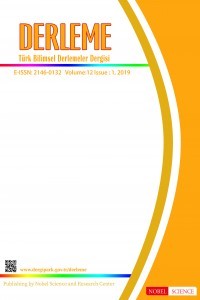Süt ve Süt Ürünlerinde Bulunan Başlıca Mikotoksin Türü: Aflatoksinler
Aflatoksinler, gıdalar ve yemlerin üzerinde/içinde bulunan Aspergillus flavus, A. parasiticus, A. nomius, bazı Penicillium ve Fusarium türlerinin ürettiği, yüksek derecede toksik, kanserojenik, teratojenik, ve mutajenik olan mikotoksinlerdendir. Aflatoksin türevleri içinde toksik ve kanser yapıcı etkisi en fazla olan Aflatoksin B1 (AFB1)’dir. Özellikle kontamine yemlerle alınan AFB1, sindirim sisteminde metabolize olarak hayvanların sütlerine Aflatoksin M1 (AFM1) olarak geçmektedir. Bu ürünleri, günlük yaşam ve diyetlerinde sıklıkla tüketen insanların, özellikle de bebek ve çocukların sütte bulunan AFM1 toksinine maruz kalma riski daha da yüksektir. Bu durum süt ve süt ürünlerinde bulunan AFM1 düzeyi tespitinin halk sağlığı açısından ne kadar önemli olduğunu göstermektedir. Bu derlemede, AFM1’in süt ve süt ürünleri için önemi, dünyada ve ülkemizde süt ve süt ürünlerinde bulunan AFM1 miktarları ve ülkemizde üretilen süt ve süt ürünlerinin AFM1 açısından risk potansiyeli tartışılmıştır.
Anahtar Kelimeler:
Aflatoksin M1, Süt ve ürünleri, Aspergillus
The Principal Mycotoxin Species in Dairy Products: Aflatoxins
Aflatoxines are produced by some types of Aspergillus (Aspergillus flavus, A. parasiticus, A. nomius), by some types of Penicillium and Fusarium on/in foods and feeds. They are highly toxic, cancerogenic, teratogenic and mutagenic mycotoxins. Among of aflatoxine types, Aflatoxine B1 (AFB1) is the most toxic and one. AFB1 which is taken particularly from contaminated feed passes into the milk of the animals as Aflatoxine M1 (AFM1) after being metabolized in the digestion system. It is a high possibility that people who consume such kind of milk in their daily life and diets and particularly the babies and the children will be exposed to AFM1 found in the milk. In this study, importance of AFM1 in dairy products, the amounts of AFM1 that may be found in milk and milk products in our country and in the world will be put forward and the risk potential of the milk and milk products produced in our country will be discussed in terms of AFM1
Keywords:
Aflatoxin M1, Dairy Products, Aspergillus,
- Başlangıç: 2008
- Yayıncı: Nobel Bilim ve Araştırma Merkezi Limited
Sayıdaki Diğer Makaleler
Süt ve Süt Ürünlerinde Bulunan Başlıca Mikotoksin Türü: Aflatoksinler
Antimikrobiyal Ajan Olarak Bitki Bileşenleri
Kentsel ve Kırsal Alanların Planlanmasında Kimliğin Rolü
Gıdalarda Kullanılan Mikrobiyal Kaynaklı Pigmentler
Oscar (Astronotus ocellatus Agassiz, 1831) Üretimi
Bitki Doku Kültürü Çalışmalarında Somaklonal Varyasyon
Yeşim KORKMAZ, Hatice ÇÖLGEÇEN
Allium Türlerinin Islahında Haploidi Tekniğinden Yararlanma
Şadiye Gül BOZDOĞAN, Cemil İŞLEK, Recep KARA, Tülay EZER
Kitosan Üretimi ve Özellikleri İle Kitosanın Kullanım Alanları
Nermin KARATON KUZGUN, Ayşe Gürel İNANLI
Doğada Yararlı Mikroorganizmalar Arasındaki Etkileşimler ve Tarımsal Üretimde Önemi
